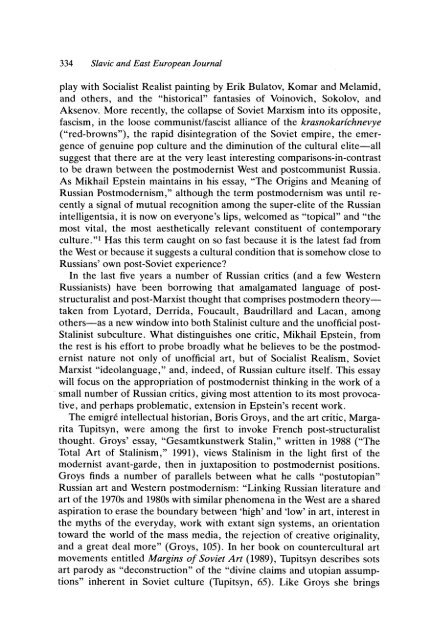Edith W. Clowes.pdf
Edith W. Clowes.pdf
Edith W. Clowes.pdf
Create successful ePaper yourself
Turn your PDF publications into a flip-book with our unique Google optimized e-Paper software.
334 Slavic and East European Journal<br />
play with Socialist Realist painting by Erik Bulatov, Komar and Melamid,<br />
and others, and the "historical" fantasies of Voinovich, Sokolov, and<br />
Aksenov. More recently, the collapse of Soviet Marxism into its opposite,<br />
fascism, in the loose communist/fascist alliance of the krasnokarichnevye<br />
("red-browns"), the rapid disintegration of the Soviet empire, the emer-<br />
gence of genuine pop culture and the diminution of the cultural elite-all<br />
suggest that there are at the very least interesting comparisons-in-contrast<br />
to be drawn between the postmodernist West and postcommunist Russia.<br />
As Mikhail Epstein maintains in his essay, "The Origins and Meaning of<br />
Russian Postmodernism," although the term postmodernism was until re-<br />
cently a signal of mutual recognition among the super-elite of the Russian<br />
intelligentsia, it is now on everyone's lips, welcomed as "topical" and "the<br />
most vital, the most aesthetically relevant constituent of contemporary<br />
culture."' Has this term caught on so fast because it is the latest fad from<br />
the West or because it suggests a cultural condition that is somehow close to<br />
Russians' own post-Soviet experience?<br />
In the last five years a number of Russian critics (and a few Western<br />
Russianists) have been borrowing that amalgamated language of post-<br />
structuralist and post-Marxist thought that comprises postmodern theory-<br />
taken from Lyotard, Derrida, Foucault, Baudrillard and Lacan, among<br />
others-as a new window into both Stalinist culture and the unofficial post-<br />
Stalinist subculture. What distinguishes one critic, Mikhail Epstein, from<br />
the rest is his effort to probe broadly what he believes to be the postmod-<br />
ernist nature not only of unofficial art, but of Socialist Realism, Soviet<br />
Marxist "ideolanguage," and, indeed, of Russian culture itself. This essay<br />
will focus on the appropriation of postmodernist thinking in the work of a<br />
small number of Russian critics, giving most attention to its most provoca-<br />
tive, and perhaps problematic, extension in Epstein's recent work.<br />
The emigre intellectual historian, Boris Groys, and the art critic, Marga-<br />
rita Tupitsyn, were among the first to invoke French post-structuralist<br />
thought. Groys' essay, "Gesamtkunstwerk Stalin," written in 1988 ("The<br />
Total Art of Stalinism," 1991), views Stalinism in the light first of the<br />
modernist avant-garde, then in juxtaposition to postmodernist positions.<br />
Groys finds a number of parallels between what he calls "postutopian"<br />
Russian art and Western postmodernism: "Linking Russian literature and<br />
art of the 1970s and 1980s with similar phenomena in the West are a shared<br />
aspiration to erase the boundary between 'high' and 'low' in art, interest in<br />
the myths of the everyday, work with extant sign systems, an orientation<br />
toward the world of the mass media, the rejection of creative originality,<br />
and a great deal more" (Groys, 105). In her book on countercultural art<br />
movements entitled Margins of Soviet Art (1989), Tupitsyn describes sots<br />
art parody as "deconstruction" of the "divine claims and utopian assump-<br />
tions" inherent in Soviet culture (Tupitsyn, 65). Like Groys she brings

















